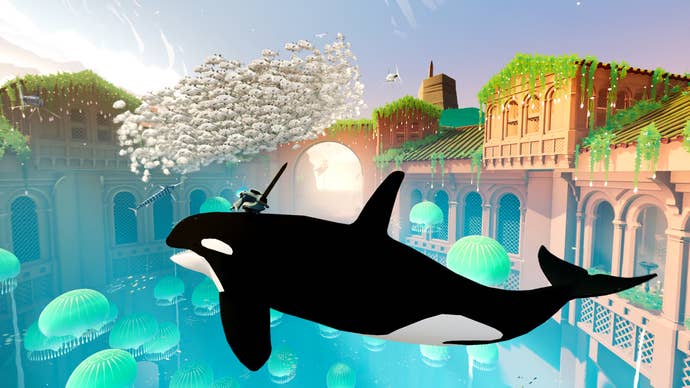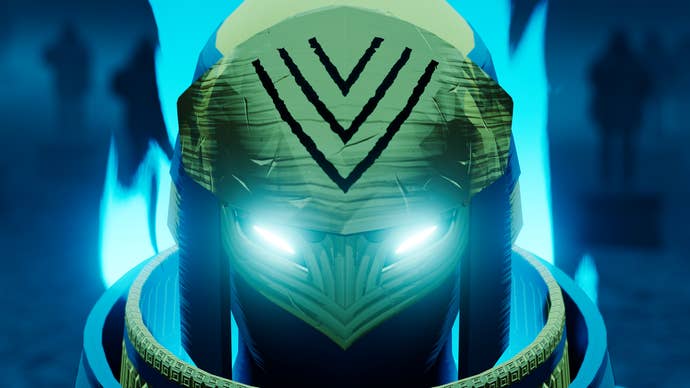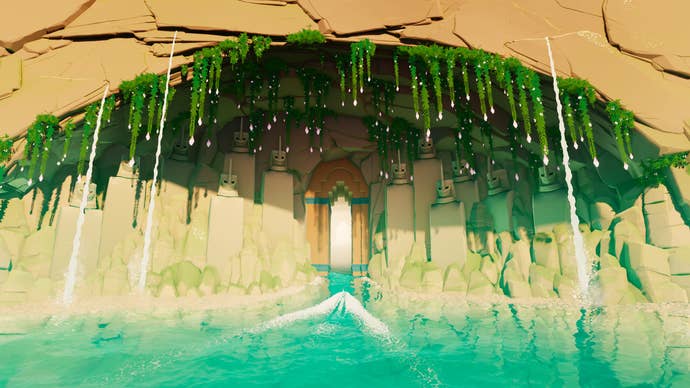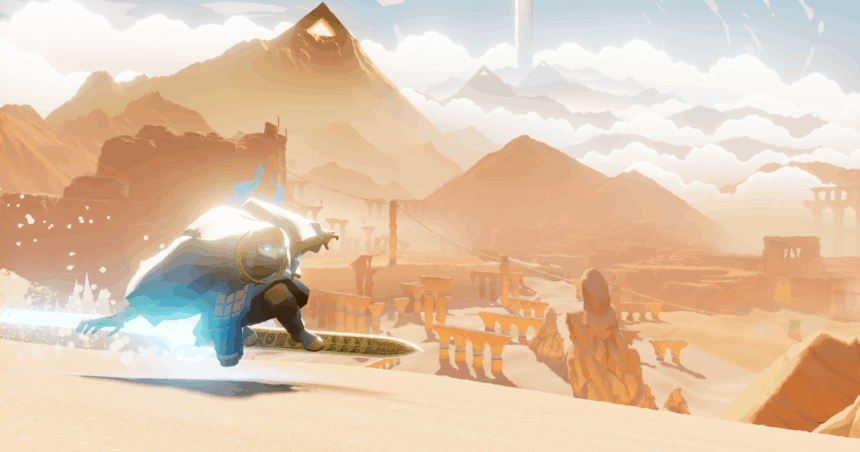“First of all, it’s just super fun in a video game to move,” Matt Nava tells me, with the certainty of someone stating the absolute obvious. And he’s dead right.
“Entire categories of games are about movement – racing games, snowboarding games – but they’re often very much, in terms of gameplay, a race. Or a point contest. There’s not a lot of exploration games.” Enter, Sword of the Sea, developer Giant Squid’s latest after the exquisitely meditative Pathless and Abzû: “What about a game where you have all that fun movement, in the context of an exploration game?”
I first spoke to Nava, creative director at Giant Squid, back at Summer Game Fest in June, but my time with the game – and talking about it with Nava – is more than easy to recall. Amongst the upbeat but forever hurried show floor of video games mass-press event, Sword of the Sea was a plunge into gentle, familiar tranquility.
From around half an hour with it I can tell you with certainty: this is a game of near peerless flow – though it’s flow of a very specific kind. Normally flow-state games come as a result of pressure, the kind of mesmeric focus that’s forged like a diamond. Sword of the Sea’s is like the flow of water itself. And the news that it’s coming to PS Plus at launch next week is the perfect excuse to finally sit down and evangelise for it, because if you’ve got a subscription to that, let me tell you: you are in for an absolute treat.
Exit your hibernation chamber of a cave, claiming your mystically imbued sword of some kind of wordless destiny – there’s a lot of Zelda here, you’ll quickly notice, pot-smashing included – and you’re away. Your sword is a surfboard, skateboard, snowboard, whatever. The dunes are your waves. Go see what they offer up.
“In this game, it’s really about how movement is a way for you to connect with the world,” Nava says. He likens it to snowboarding, one of a few “extreme sport” reference points that ring out here. “You’re going fast down the mountain; you get to see all of the mountain very quickly. It’s the closest you can be to being everywhere at once. It’s the closest you can be to having a total understanding of the entire space. That movement lets you understand the world in a different way.”
The extreme sport angle is an important one for Nava and Giant Squid, in the way it marries mindfulness and motion. “It’s the same thing with Abzû,” he says. “I went scuba diving, and every video game where you’re diving, it’s like: you’ve got an air meter. You’re super stressed out. The sharks are about to kill you – you’re about to die! The Sonic music is going dee-doo-dee-doo-dee-doo,” he laughs.



“And when you’re actually scuba diving, you jump in the water, you have way more air than you would ever need. You’re in the shallows. It’s sunlit, there’s beautiful fish. You’re floating. You just hear your own breath. It’s like you’re meditating. You’re forced to just relax. It’s the most calming, beautiful – it’s nothing like what you see in video games. I was like: where is that? And it’s the same thing with extreme sports like snowboarding and surfing, I just wasn’t seeing that around. And that’s the part that’s special to me.”
As you surf the desert waves in Sword of the Sea you’ll collect a few shiny prisms of currency – often from smashing those pots, in fact, though more often from simply exploring. Sword of the Sea is instructional, in a sense; the same sense that a lot of the really magic video games are. You have a button to jump and double-jump – there just because it feels good, I suspect – and one to send out a little pulse, held down for a slightly wider one. And one you hold, the left bumper, that lets you mash the other buttons to do a few tricks when up in the air. With those few interactions you have all you need: do a little pulse by some shiny object of universal video game language – a treasure chest, a little glowing pad, a funny-looking guy, a gaggle of smashable pots – and of course, results. Cause and effect in real time.
Complete a little area of gentle, rhythmic platforming – through a little cave you discovered, say, or across some ruined bridges and fallen statues – and Sword of the Sea reveals the reason for its name. Suddenly desert is replaced with ocean, lifelessness and giant skeletons with flying fish and floating whales. And then your real reward: usually some kind of big, lovely slide to lance your way through at hyper speed, full of those golden not-coins. Collect enough and bring them to the funny-looking guy, and you get a little upgrade. Bring water and life to enough of the world and new areas open. New dunes to slice through, walls to grind, ancient buildings with – what’s that? Only a lovely little half-pipe to ride.

“A lot of times when games are made, you think about simulating – or think about the kind of surface qualities of a subject matter,” Nava says. “But if you think one step deeper about why people are doing it, you try and capture that, it’s a much more challenging problem a lot of the time. But that’s, I think, more rewarding in a way… because it lets players have a different kind of experience with it, on a deeper level.”
Nava’s games, from his work as art director on Journey through the wider studio of Giant Squid’s work in Abzû and The Pathless, has often had a tinge of spirituality. Inevitably the conversation turns that way, on a sofa in a wide open hall, in front of a big TV and a pause menu, surrounded by laughter, chitchat and virtual gunfire. “When people talk about the games that they love, they talk about that kind of life-changing, moving experience. People have spiritual connections they build with video game experiences – even ones like that,” Nava laughs, though I should say totally earnestly, nodding towards a rattling machine gun on a screen nearby.
“I think spirituality is this weird topic in the modern world,” he goes on, referencing the “open questions” of the ancient world with the more settled parts of science today. “The human mind still needs some kind of spiritual connection to the world, and to be motivated, to have hope.” Sword of the Sea’s attempt, from what I’ve played so far, is to offer up a few small open questions of its own, to channel myth and religion through obvious allusions and little moments of symbolism, to offer the same kind of spiritual connection you might have, in some way, when racing downhill, or down a mountain, or across the sea. A little bit of oneness with the world you’re moving through, and an open path for you to forge ahead.





